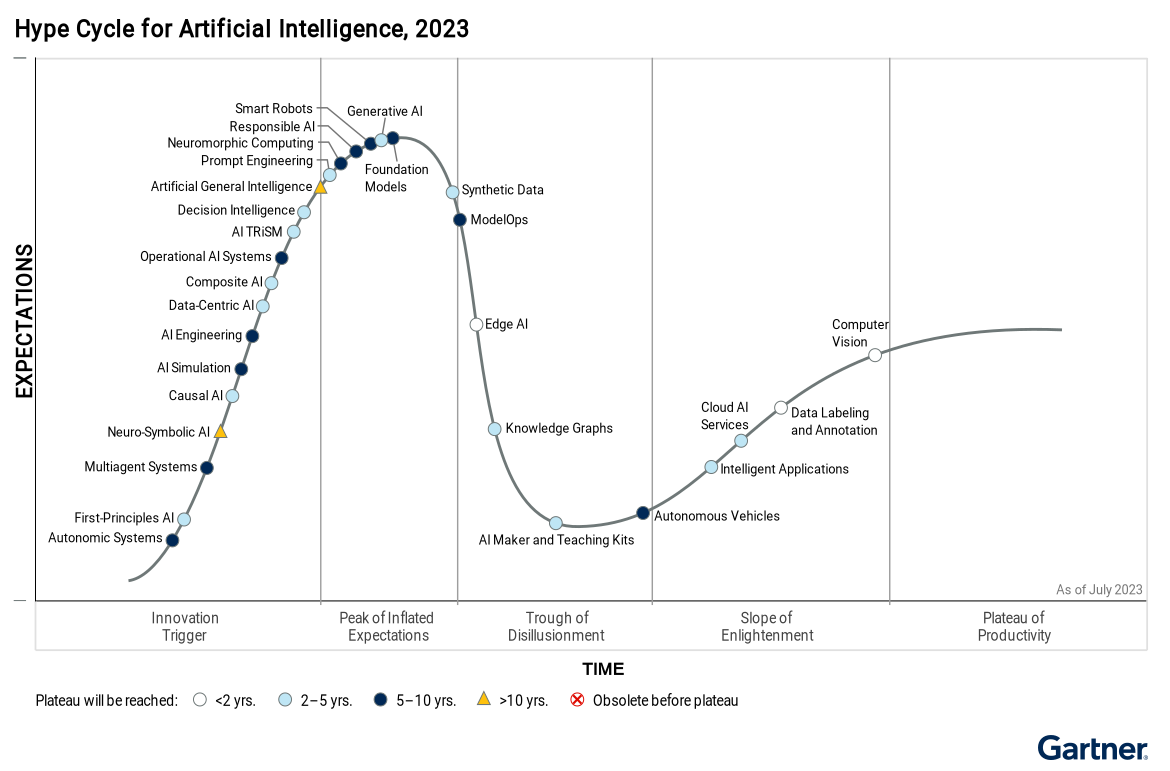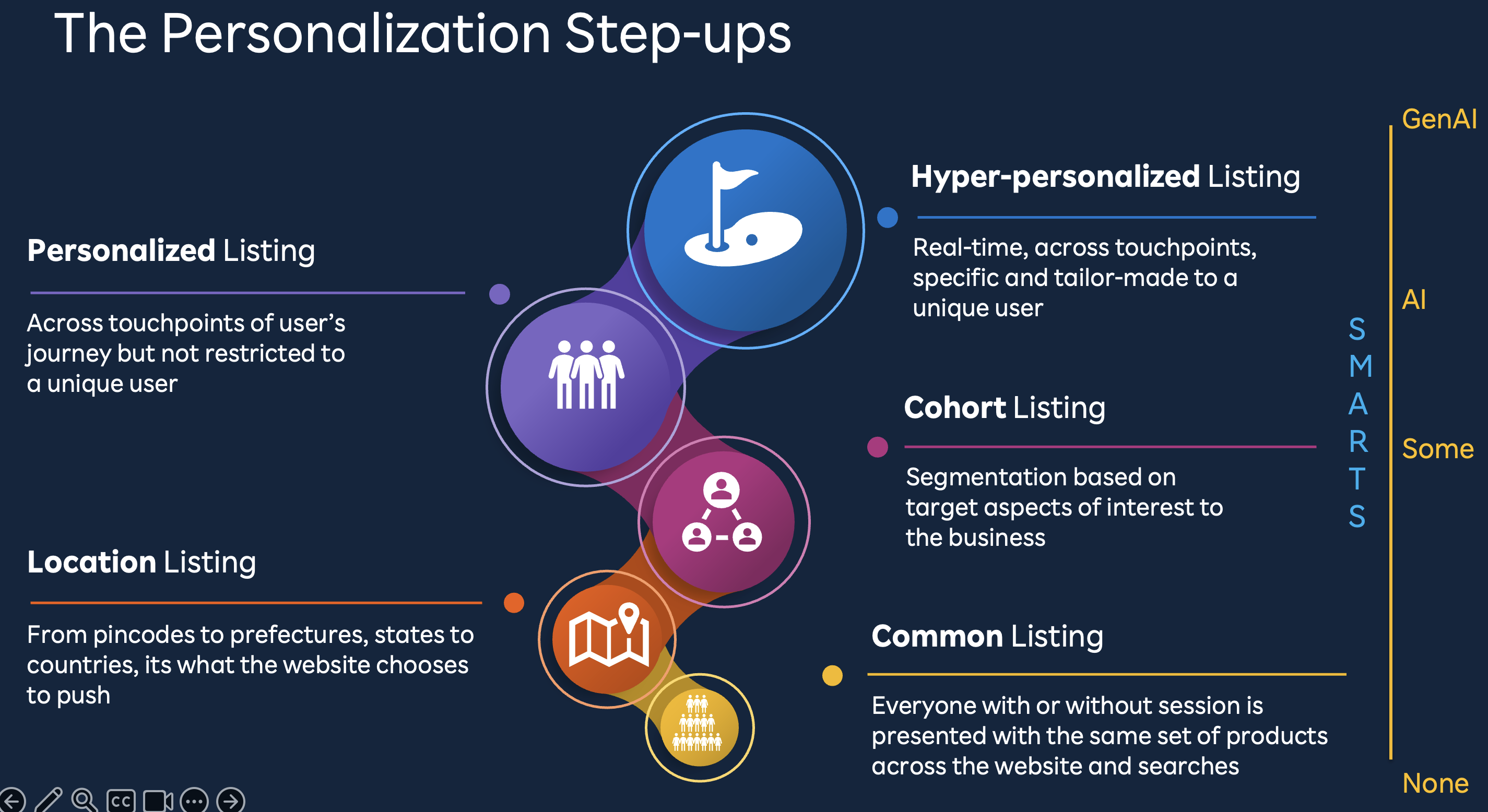Hyper-personalisation in the age of GenAI
“do not send the customer back empty handed” – a sign-off statement from my businessman neighbour to his heir son, when on his lunch break. “ask and you shall receive!” – is a statement every business wants to tell their customer, towards fulfilling the shopping desires they walked in with. While user experience has a telling impact across the user’s journey, tech has begun to play a role, more crucial than ever. In recent times most of it resolves around GenAI. One of the many indicators, Gartner’s Hype Cycle puts both GenAI and LLM in the peak of the inflated expectation bracket for 2023. Be it an end customer or a business, a product manager or a marketeer, an engineer or a data scientist, it's imperative to ride this tide – for the transformation you can bring about to your respective customers can be the difference between the success of yours and that of your competitors, and perhaps the industry as a whole.

Ref: https://www.gartner.com/doc/reprints?id=1-2EIDK8BU&ct=230720&st=sb
A key ingredient to consistently delivering great customer experiences is to be able to understand them hopping beyond the barriers of language, region and rest of the demographics. Personalization sits at the heart of this. 70% + customers move on if a website doesn’t offer a personalized experience. Websites have been at this for decades, but given that the average conversation rates hover between 2-4% across the world, there is so much more that can be done. Perhaps with the GenAI now, its carp-e-diem time, more so with the rise of vector databases, the success, embeddings are bringing about.

Shortening the time to personalising, effectively:
Starting afresh or diversifying across categories, certain aspects of personalisation vary. For instance, the way a use-base for the electronics category go about searching for a product is very different from the ones for the fashion category. The same individual might go about the search for the aforementioned categories differently. Hence the semantic abilities of a search platform are to be sent for a do-over across aspects ranging from language nuances to that vector embeddings. With the advent of LLMs and the leverage in the form of retrieval augmented generation (RAG), re-training foundation models can be strategized towards speed.
AI Customer service that doesn’t sound robotic, finally:
As more of the internet-savvy customers are acclimatizing themselves to prompt-based interactions, the robotic mode of responding to them with mediocre responses chatbots, won’t be tolerated anymore. GenAI is making it possible to serve customers beyond the realm of feeding straight lines and single-word responses, towards intuitive studded conversations that are more immersive and perhaps take the matters to closures themselves, than having to pass it onto human tech support. For instance, Jane ordered for an Asics shoe but it didn’t fit well, is now reaching out to customer support for a refund. GenAI can be leveraged to offer a meaningful conversation towards “negotiating” with Jane and offer her an alternative to being aware of her preferences and awareness of the brand and such. This was either not done or possible in limited ways until now, but GenAI changes it all.
Catalog creatives, mission it is all-possible:
Product images are important constructs of a catalog, especially in certain categories such as fashion. At times the product might have more than a handful color variants and variants. Imagine millions of such products exist, standardizing them is a herculean task let alone get into personalizing them. Up until now, the former was the priority and the latter would follow but with GenAI, highly personalized product catalogs can be offered towards successfully converting the transaction to a sale. For instance Richard and Shinoda are two different customers across regions, and have narrowed down on a North Face jacket for the winter. GenAI can be leveraged to personalize the catalog images to show background for the jacket, one with the Grand Canyon and the other with Mt. Fuji, thus giving the website a higher chance of appealing to them.
Informative yet compelling summaries:
The reviews section is one of the top 3 support systems for a successful sale on a website. Accompanying this section is the Questions and Answers section, the content of which is crowdsourced between the website, the merchant(s) and the buyers. For a fairly popular or high-selling product, these sections can get busy. What if the customer has 1000s of reviews and 100s of QnAs to go thru before making a well-educated purchase decision? GenAI can be leveraged to reduce to cognitive load on this front, so the customer’s attention can be better put to use to cherry-pick one amongst multiple payment offers. Language-agnostic LLMs can be leveraged towards not just summarizing 1000s of reviews, but also auto-generate newer QnAs.
The application areas are aplenty, across eCommerce, Fintech, Healthcare, Mobile and so on. As many newer possibilities GenAI offers, they all come at the cost of various inputs involved, including tech. Companies have to start drawing short-term to long-term strategies ranging from investments on this front, to directions they’d want to steer their customers and hence their businesses, and therefore the industries as a whole. Doesn’t matter if companies choose to leverage what is available or resort to building custom LLMs, cognizance of all aspects of data will be critical. That is where GenAI can also render itself in revamping, rectifying and filling gaps in heaps of legacy information that posed challenges towards usage. As all of this and more are done, websites and apps will be able to leap beyond content filtering in listings and offerings, to derived, intuitive and hyper-personalised content to hopefully breach the current conversation rates! For now, GenAI says, abra-ca-data!
Thank you
Ganeshkumar (GK)




